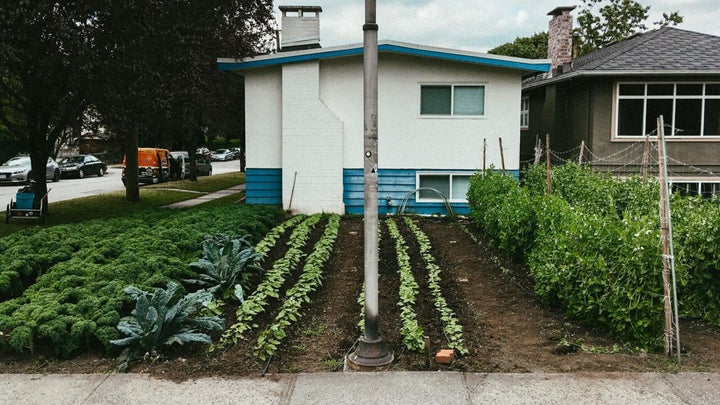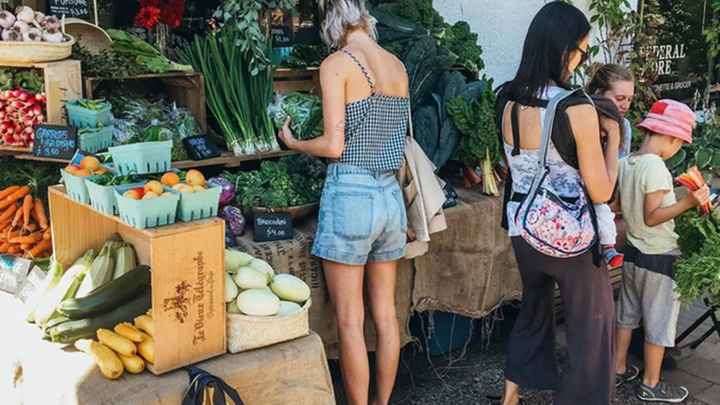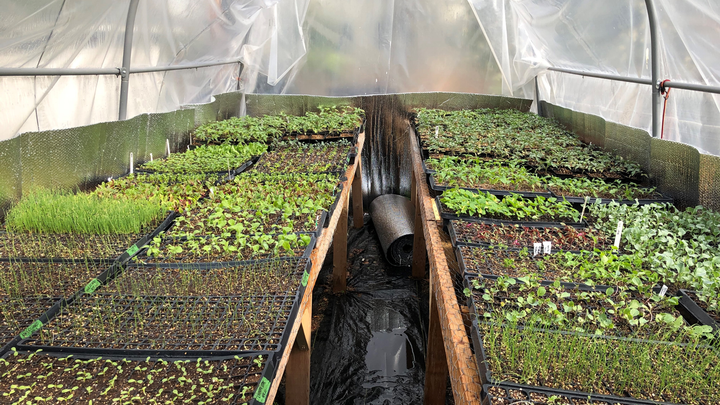
Neither of us grew up farming. Truthfully, up until a few years ago we couldn’t even tell you what a pepper plant looked like! Now, we grow vegetables and cut flowers across 15 residential front and backyards in East Vancouver, where we’ve helped nurture our community for the past four seasons.
In 2013, two young women much like us were faced with the biggest obstacle to aspiring farmers: access to land. Katie and Ruth, City Beet’s founders, canvassed neighbourhoods with the idea of farming people’s yards. It was then that City Beet Farm took root across six lawns, all within biking distance of one another.
We purchased the business when it went up for sale in 2016, and put our combined backgrounds in business and soil science to work.

Growing food, for us, feels like a hands-on, tangible way to exercise our commitment to the land and to building community. We take great care of the soil to grow nutritious food that our communities can feel good about feeding their families. Like all the best gifts, food is best fresh and from hands you recognize.
Responding to the COVID-19 crisis
The COVID-19 pandemic has highlighted the fragility of our food system. Many folks who live in urban centres across the country have never before experienced walking into a grocery store and finding shelves upon shelves bare. As the cracks show in our dependency on imported food, there is renewed inspiration for “victory gardens” and Grow Your Own.
We are encouraging folks to get their hands in the soil or connect with their local farmers and decrease their reliance on the global supply chain. Our farm has responded to the crisis by seeding earlier in the season than past years and growing as much food as is within our capacity. We also provide educational content to inspire folks to grow their own food and decrease their reliance on the complex food system.
We are hopeful that after learning more about this lifestyle – and trying a bit of farming themselves — folks will continue to eat locally and support small farms long after this pandemic.
How we feed our neighbours
City Beet Farm’s six original yards fed roughly 20 households weekly from June to October. Today, with 15 yards totalling 0.5 acres, we are able to feed over 100 households every week. While some homeowners are part of City Beet to support young farmers, others are simply happy to not have to mow their lawn — and through their generosity, we are able to grow over 35 different crops.

We trade these homeowners vegetables for the use of their land, and sell the rest through a ”community supported agriculture″ (CSA) model, which sees 82 members pick up a freshly harvested veggie box weekly when crops are in season. Anything left over is sold through pop-up markets in collaboration with a local Vancouver coffee shop, The Federal Store.
What to grow in an urban garden
The goal when growing food in an urban setting isn’t to grow everything in your diet. Space-intensive crops like corn, potatoes, grains, onions, dry beans and other pulses are slow to mature and unlikely to be worthwhile where space is limited. Focus your resources on quick-turnover crops and those that can be harvested over a long period of time, like kale, Swiss chard, parsley, tomatoes and perennial herbs.
There are many vegetables that can be planted densely together to produce lots of yield. These include greens like spinach, arugula, lettuce and mustards. Radishes can also be planted densely and mature quickly, so it is very possible to produce three to four harvests over the course of a summer.
Many crops, like snap peas, cucumbers or zucchini, bear loads of fruit growing vertically if you build them some support. If you live in an apartment, this could be as simple as growing them in a planter with a supporting trellis.

We seed some crops, like carrots and salad greens, directly into the garden. Others, like tomatoes or peppers, we start under grow lights before transferring them to an old carport-turned-greenhouse until they are mature enough to be transplanted. Many people have great success with a single grow light indoors and a small greenhouse on their patio. No matter your method, you want to ensure your plants get adequate light to avoid becoming “leggy” (excessively long), and have good airflow and warm-enough temperatures.
Preparing a garden space
A few hundred square feet of garden — about the size of a parking spot — with seven to eight hours of unobstructed sunlight a day is sufficient to grow vegetables for a household. When planning where to grow, think about how sunlight travels across the space, and where shadows will form as plants grow taller, and plan your garden layout around that. For those of us that are not lucky enough to access full sunlight, consider more shade-tolerant crops such as lettuce, parsley or kale.
We maximize our planting space by making long, 36-inch-wide planting beds with 12 to 18-inch pathways between them. When planting more than one crop in a single bed, we group them in blocks.
Maintaining an urban garden
Watering a garden seems like a simple task, but it is actually quite an art. Water must reach deep into the soil, so do your best to ensure you are not just watering superficially. But too much water will drown your plants. Test soil with the tip of your finger to gauge moisture — it should feel moist, but not soggy. Remember that shadier gardens tend to dry out more slowly, while sunny yards will require more frequent watering.
There is no substitute for careful observation and spending time in the garden with the plants — we take a close look a couple times a week at minimum. Checking the underside of leaves for little eggs or larvae is one way to tell if there are any potential pests.
Pests and disease pressures are a concern if you grow the same crop, over and over, in the same bed. You can avoid this by organizing with neighbours and concentrating on growing two to five crops each, then rotating who grows what every season. You will boost your yield, maintain good diversity in your space, and can take advantage of each yard’s unique characteristics, like shading or soil type.
Don’t fear failure
Although it’s always disappointing, we try not to be discouraged when things fail. Farming is full of failures, even for the very experienced among us. We seed a minimum of 30 per cent more than we expect to harvest to suffer losses we know will occur. This is the humble reality of growing food.
While we don’t expect urban farms to feed a whole city, front-yard farming connects people closer to their food and their farmers, and gives them a chance to try it out for themselves. Whether you feel inspired to take your lawn from grass to harvest in as little as 14 weeks, or to support your local small-scale farmer, the pandemic provides the opportunity to decrease our reliance on a complex global food system and reconnect with our land.
Have a personal story you’d like to share on HuffPost Canada? You can find more information here on how to pitch and contact us.
Also on HuffPost: